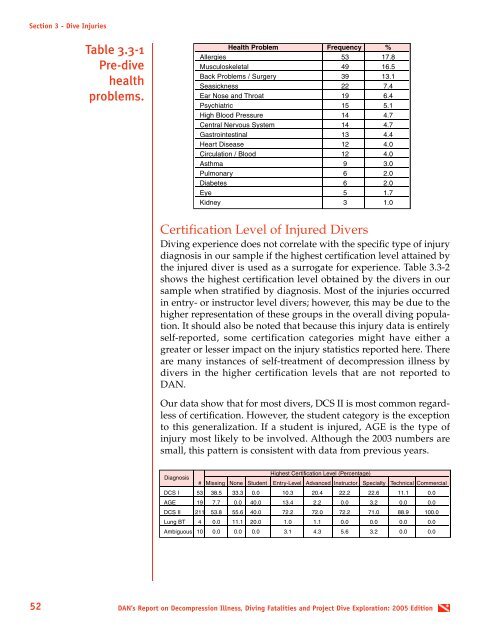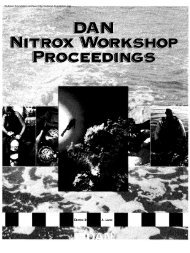Report on Decompression Illness, Diving Fatalities and Project Dive
Report on Decompression Illness, Diving Fatalities and Project Dive
Report on Decompression Illness, Diving Fatalities and Project Dive
- No tags were found...
Create successful ePaper yourself
Turn your PDF publications into a flip-book with our unique Google optimized e-Paper software.
Secti<strong>on</strong> 3 - <strong>Dive</strong> InjuriesTable 3.3-1Pre-divehealthproblems.Health Problem Frequency %Allergies 53 17.8Musculoskeletal 49 16.5Back Problems / Surgery 39 13.1Seasickness 22 7.4Ear Nose <strong>and</strong> Throat 19 6.4Psychiatric 15 5.1High Blood Pressure 14 4.7Central Nervous System 14 4.7Gastrointestinal 13 4.4Heart Disease 12 4.0Circulati<strong>on</strong> / Blood 12 4.0Asthma 9 3.0Pulm<strong>on</strong>ary 6 2.0Diabetes 6 2.0Eye 5 1.7Kidney 3 1.0Certificati<strong>on</strong> Level of Injured <strong>Dive</strong>rs<strong>Diving</strong> experience does not correlate with the specific type of injurydiagnosis in our sample if the highest certificati<strong>on</strong> level attained bythe injured diver is used as a surrogate for experience. Table 3.3-2shows the highest certificati<strong>on</strong> level obtained by the divers in oursample when stratified by diagnosis. Most of the injuries occurredin entry- or instructor level divers; however, this may be due to thehigher representati<strong>on</strong> of these groups in the overall diving populati<strong>on</strong>.It should also be noted that because this injury data is entirelyself-reported, some certificati<strong>on</strong> categories might have either agreater or lesser impact <strong>on</strong> the injury statistics reported here. Thereare many instances of self-treatment of decompressi<strong>on</strong> illness bydivers in the higher certificati<strong>on</strong> levels that are not reported toDAN.Our data show that for most divers, DCS II is most comm<strong>on</strong> regardlessof certificati<strong>on</strong>. However, the student category is the excepti<strong>on</strong>to this generalizati<strong>on</strong>. If a student is injured, AGE is the type ofinjury most likely to be involved. Although the 2003 numbers aresmall, this pattern is c<strong>on</strong>sistent with data from previous years.DiagnosisHighest Certificati<strong>on</strong> Level (Percentage)# Missing N<strong>on</strong>e Student Entry-Level Advanced Instructor Specialty Technical CommercialDCS I 53 38.5 33.3 0.0 10.3 20.4 22.2 22.6 11.1 0.0AGE 19 7.7 0.0 40.0 13.4 2.2 0.0 3.2 0.0 0.0DCS II 211 53.8 55.6 40.0 72.2 72.0 72.2 71.0 88.9 100.0Lung BT 4 0.0 11.1 20.0 1.0 1.1 0.0 0.0 0.0 0.0Ambiguous 10 0.0 0.0 0.0 3.1 4.3 5.6 3.2 0.0 0.052DAN’s <str<strong>on</strong>g>Report</str<strong>on</strong>g> <strong>on</strong> Decompressi<strong>on</strong> <strong>Illness</strong>, <strong>Diving</strong> <strong>Fatalities</strong> <strong>and</strong> <strong>Project</strong> <strong>Dive</strong> Explorati<strong>on</strong>: 2005 Editi<strong>on</strong>
















